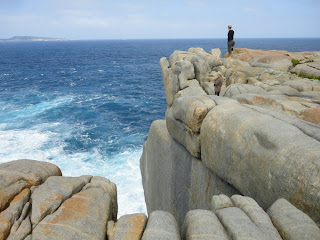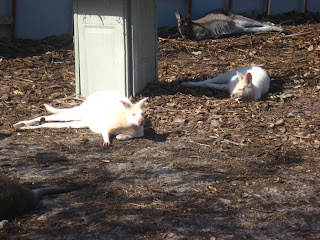Saturday 15th October
This morning we headed off with a full schedule of things to do before getting back to camp to watch the France - Wales Rugby game, which was due to be shown at 4.00pm.
Our first stop was on the edge of the cliffs at The Gap and Nature’s Bridge. The Gap is a narrow channel carved into the rock over millions of years by the sea. The Southern Ocean crashes into the south coast of Australia all along this coast, with nothing between Australia and Antarctica.
About 100 meters away is Nature’s Bridge, also formed by millions of years of erosion by the sea.
It was quite incredible to stand on the cliff top and watch the awesome raw power of the sea as it bashed away at the rock cliff face. Wave after wave relentlessly pounding into the cliff, then surging out only to smash into the next wave charging in. Something you could stand and watch for hours. Another magnificent example of nature doing her thing. Photos couldn’t do this justice, so we videoed the action.
If you want to watch it you’ll have to invite yourself around to our place once we get home. Entry fee will be a bottle of Bourbon and a bottle of Brandy.
From there we drove further along the coast to the Blowholes. Again these were down on the cliff face where the seas had eroded under the cliff allowing water and air to get trapped by incoming waves, forcing huge blasts of air out through the holes in the rocks.
From the Blow Holes we drove to Whale World which is based at the old whaling station. Huge circular tanks that once held thousands of gallons of whale oil now contain cinemas showing all aspects of the history of the whaling industry.
We joined a conducted tour of the sight and learnt all about how important the whaling industry was to the economy of early Australia, and how it was finally forced to close in 1978, due to a combination of lack of demand for whale oil, and pressure from the likes of Greenpeace demanding that the killing of whales stop.
We saw huge skeletons of whales and the huge ovens used to render down the whale blubber to make oil. On average 7 tonnes of oil was obtained from a 40 tonne whale. As well as 101 different uses for the oil, no part of the whale was wasted. Even the bones skin and stomach were broken down and cooked up for by products such as blood and bone, stock food and fertilizer.
We all found it quite upsetting seeing some of the photos of whales being killed and cut up, and to be actually standing on the very place where all this slaughter had occurred, listening to a recording of the sounds as the slaughter took place. Having watched these magnificent animals frolicking in the sea at Exmouth, and knowing as much as we do today as to just how intelligent they are, you can’t help but wonder how anybody could kill these magnificent creatures.
To cheer ourselves up, we visited the nearby wildlife park where we saw quokkas, wombats, pademelons, (they were the little wallaby like animals that came right up to our tent while we were camping at Freycinet National Park in Tasmania), wallabies, kangaroos, including two very rare white ones, possums, again two rare albinos, and potaroos, (small kangaroo like animals).
But the icing on the cake were two koalas. They were basically roaming free in their enclosure, and when we went in, one was sitting on the fence rail eating gum leaves.
He then entertained us by walking along the rail beside us, for about 20 meters to another bunch of gum leaves. We were able to pat him and give him a scratch as he walked along.
After having another feed of leaves he climbed up onto a shade cloth rook, stretched out and went to sleep.
Meanwhile his mate sat in the bunch of gum leaves fast asleep right beside the walkway.
You couldn’t get any closer to koalas than this. Another fascinating experience and just the thing we needed to lift our spirits after the Whale World visit.
On our way back to the caravan we called in at a Distillery intending to try out some of their products to see if they were as good as mine, and maybe buy a bottle or two, however a quick look at the prices on their shelves, soon had us heading back out the door. Brandy from $70 for a small bottle up to $300 for 700 ml, and whisky ranging from $350 to $800 per 700ml. Can’t wait to get back home and start brewing again. Joe you have a gold mine sitting in your garage.
On the way back to the caravan we bought some chips and dip and then settled down to watch the France - Wales game, and we all know who should have won that. Never mind at least now we will have the pleasure of thrashing the French after we have thrashed the Aussies.
Sunday 16th October
Happy 6th Birthday Arlo.
One of Albany’s attractions is the reconstructed Brig, the Amity, the boat that bought the very first settlers to Albany, anchoring in the harbour on Xmas Day in 1826.
The reconstructed boat is on display at the Albany waterfront, and we enjoyed spending about an hour or so looking over her and appreciating just how hard a life the early sailors, and to a certain extent the passengers, had spending months at a time in such cramped and uncomfortable surroundings.
After the Amity, we had a look through Albany’s old Goal with its broken glass parapets,
before heading back in to town for lunch and then back to the van to prepare ourselves for the All Blacks - Wallabies game. Go the All Blacks! Tomorrow we head east again towards Ravensthorpe and Esperance.
































No comments:
Post a Comment